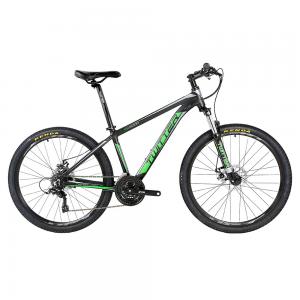
Add to Cart
SHlMANO 24 Speed Aluminum Alloy Frame Internal Cable 26/27.5/29er Inch Carbon Fiber Road Bike
specification
| Bike Model | TW3000 V4-3 |
| ConfRev | EF500-24S |
| Wheel Size | 26/27.5" |
| Frame Height | 15.5" / 17" |
| Bike Color | BlackRed / BlackGreen / BlackBlue / BlackYellow / WhiteRed |
| Net Weight | 13.5KG |
| Frame | TW3000,MTB,Lightweight AL6061,Smooth Welding, Internal cable,Matting |
| Fork | TW Alu alloy,Coil suspension,Manual-lockout,26"(27.5") |
| Derailleur Lever | SHIMANO EF500-24S |
| Front Derailleur | SHIMANO TY300 |
| Rear Derailleur | SHIMANO TZ50 |
| Cranksets | Prowheel,Alu alloy,Square-hole,24-34-42T |
| Cassettes | DNP-8S,13-28T |
| Chain | YBN-8S |
| BB | KENLI,Square axis,sealed-Bearings,BB68,Threaded |
| Brake | YINXIN cable-pull Disc brake |
| Tire | KENDA-K1187, 26"(27.5")×1.95" |
At Twitter Cycles we make one bike, a road bike. As a specialized company it’s our goal to make the best road bike
that everyone can afford. And to that effort go all our resources.
The LeadOut was designed to be ridden far, fast and often. It combines a clean, timeless aesthetic with cutting-edge
technology in carbon fiber manufacturing. The result is a true race machine that’s built to last.
Ride Quality
When we started conceptualizing this bike, we wanted to focus on more than just weight and stiffness. We put a premium
on ride quality, because ride quality and speed go hand in hand. Ride quality also makes long days better, and inspires
confidence on thrilling, twisty descents.
Durability
In this day of making the lightest possible bikes, we want you to take comfort in the knowledge that your bike is built to last.
We rigorously test our bikes during the design and manufacturing stages to ensure they meet various strict international safety standards.
Weight
Without compromising ride quality or durability, we made the LeadOut as light as we could. Frame weights range from below
700 grams for the smaller Climber layups to about 1,000 grams for the Sprinter layup. Fully built, the typical LeadOut weighs
between 15 and 16 pounds without compromising long-term reliability or safety.
all bikes could ride on roads. However, a road bike is one that's optimized for riding on smooth pavement. It usually has skinny tires (no wider than 32mm, often much narrower) with a very light tread. (If they have any tread at all. Some road tires, such as the Kojac, are treadless or "bald", to cut down on rolling resistance.) Road bikes usually have handlebars that are designed to be comfortable for long stretches of time, sacrificing a little bit of fine control that you'd get with a wider flat bar or riser bar.
By way of contrast, mountain bikes come with wider tires that have more agressive tread ("knobby" tires) designed to grip gravel or dirt.
Road bikes can sometimes ride on packed dirt or gravel, but the ride will be very harsh. A bike optimized for off-road will be
easier to control and can ride on surfaces that'd be problematic on a road bike, such as rocks, gravel, loose dirt, or pockets of sand.
There are even bikes that will accept extra-wide tires (3 - 4"). People who ride on very bad roads that have had potholes and cracks installed copiously may prefer a mountain bike to a road bike, or may decide to get a hybrid bike, which is exactly what it sounds like.










